This post covers the Astronomical Clock in Prague including tips about how to visit the landmark, what to see and do in the area, and what makes it so notable.
- The Clock Described
- Old Town Hall
- Tickets + Discounts
- Public Tours
- Self-Guided Tour of Old Town
- Things to Do in Prague
HOW THE PRAGUE ASTRONOMICAL CLOCK TELLS TIME
If you’ve seen one Prague landmark in photos, chances are that this is it.
The Prague astronomical clock, also known as Prague Orloj, is visited by astronomical numbers of tourists each year. It’s been a draw since 1410.
It's the oldest working astronomical clock in the world. It's just over 600 years old.
This beautiful medieval clock can be found in Old Town Square, on the wall of the Old Town Hall.
It was the creation of two men, a mathematics and astronomy professor, Jan Šindel, and clockmaker Mikuláš of Madaň. Later, others added their mark as restorations and modifications were made.
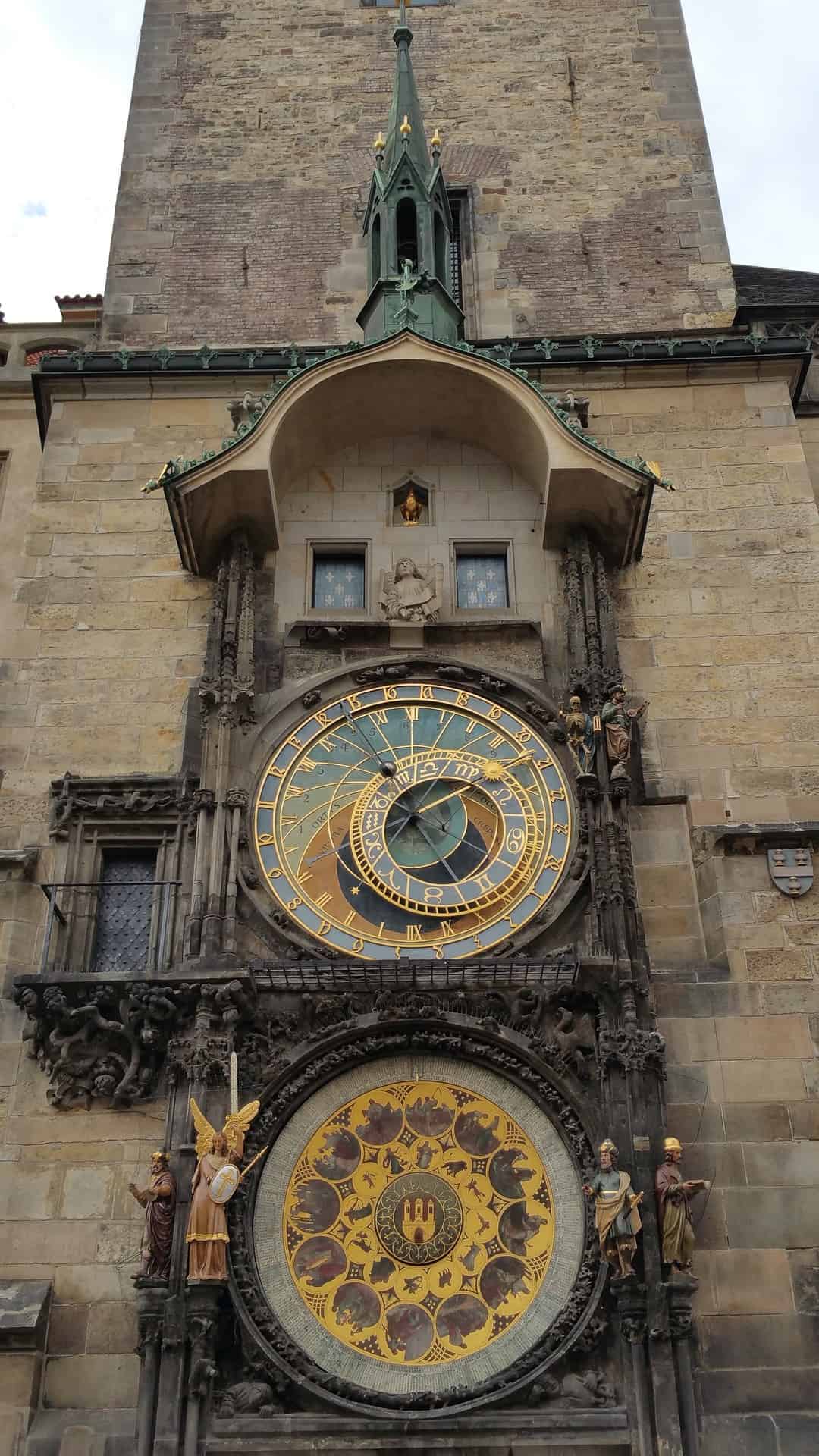
The clock sits on a clock tower although it’s close to ground level so that passing astronomers can see it in detail.
If you look at the upper face, there’s a lot of information to take in.
There are three main rings on the clock's face.
On the outermost edge, you'll find a black background with gold numerals reflecting the older form of Old Czech time, also known as Old Bohemian time or Italian time, which measured the day starting at sunset.
Timekeeping used in the Czech Republic at the time of the clock's creation was based on dividing daylight hours into 12 equal parts. That meant there were longer hours during the summer and shorter hours during the winter.
Next, in the colorful middle ring, there is a display of the 24-hour click in gold Roman numerals (I-XI repeated twice) telling the time in Prague.
The various colors indicate things like daytime, daybreak, nighttime, and as well as geographical information.
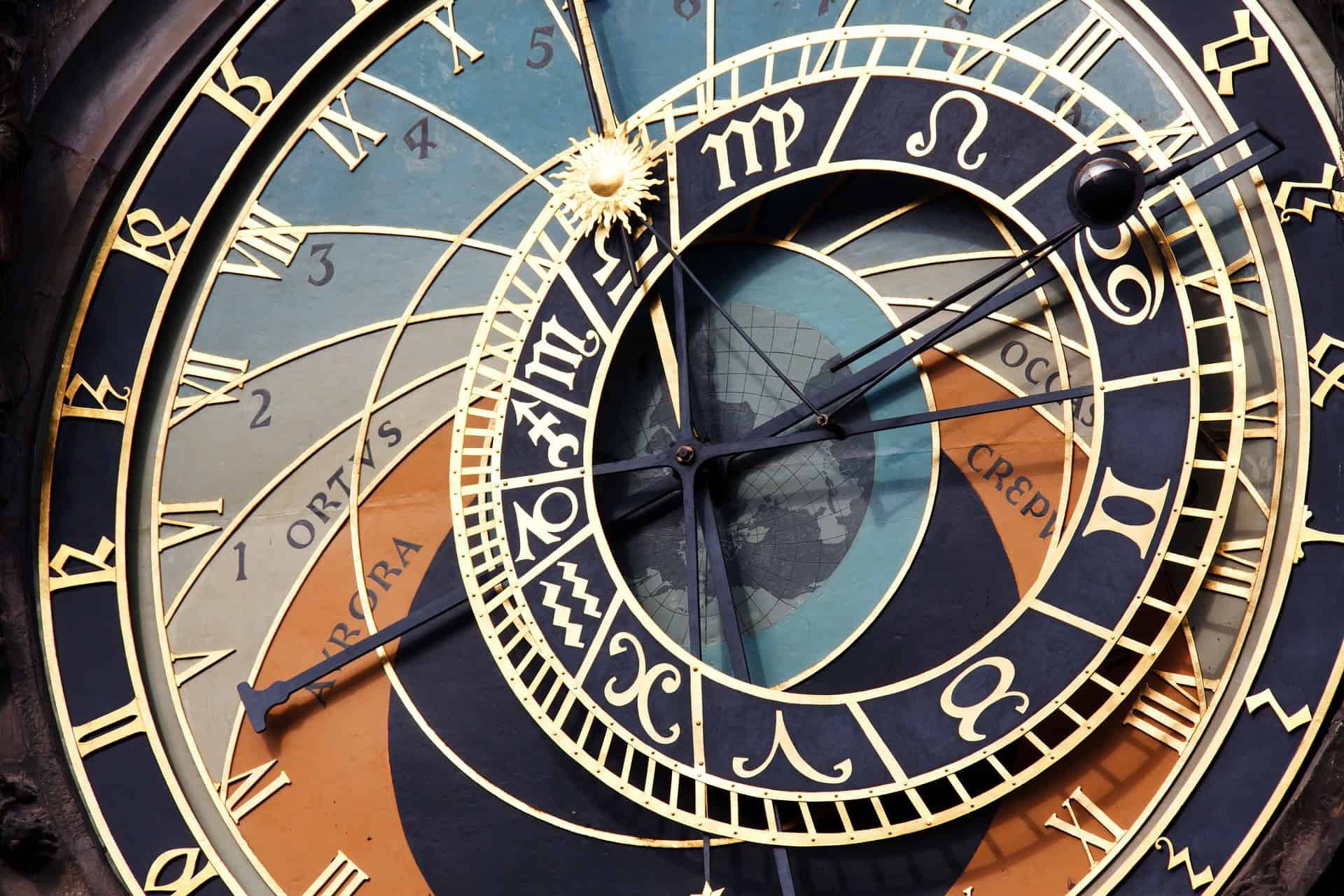
And in the center sits the Earth because at the time it was believed the Earth was the center of the universe.
There is also a Zodiacal Ring, an astronomical dial that sits on top of the clock face.
A dial with a gold sun on its tip crosses the signs of the zodiac and shows the location of the sun or ecliptic.
Another dial, this one with a moon on its tip, shows the changing phases of the moon and its movement across the sky.
A third dial, one with a small star on the tip, indicates sidereal time, which helped astronomers picture what the sky would look like that night.
The figures or statues sitting to the sides of the upper face are meant to be cautionary figures, and they are set in motion on the hour.
From left to right they are Vanity, who is holding a mirror; Greed, who is holding a bag of money; Death, the skeleton, who is holding an hourglass; and Lust/Extravagance/Pleasure, who is represented by a Turk enjoying music.
When the hour rings, the Skeleton rings his bell and the other three shake their heads as if saying "No, we're not ready to die!"
There are also windows with figures of Jesus and the Apostles that move every hour on the hour. It's known as the "Walk of the Apostles".
In order, they go James the Less and Peter, Andrew and Matthias, Thaddeus and Philip, Thomas and Paul, John and Simon, Barnabas, and Bartholomew.
The whole thing takes just a few seconds, but it attracts a huge crowd, and it happens every hour from 9 am to 11 pm.
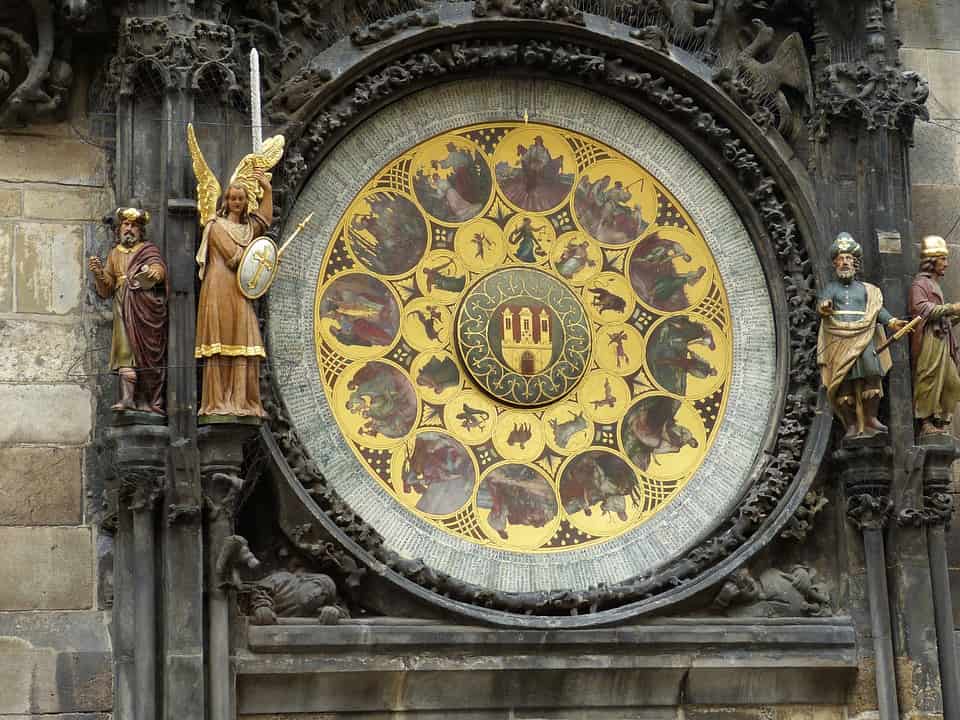
That’s just the upper face. The lower face is a calendar dial, with medallions showing the months and the zodiac signs.
This was painted by Czech painter Josef Mánes.
A copy of the disk replaced the original in 1880. The original can now be found in the Prague City Museum.
What appears from a distance to be a gray circle around the whole face is actually the most detailed part.
That ring is divided into 365 sections with the names of Christian Saints written on them to remind the viewer whose feast day it was.
The four figures on each side of that clock are a philosopher, the Archangel Michael holding his shield and sword aloft, an Astronomer, and a Chronicler.
For a period of time, it was believed that a clockmaker named Hanuš had designed the clock.
Legend had it that he was blinded by Prague councilors who were afraid he would build an even better clock for someone else.
It was said that he was driven mad by being blinded and in revenge threw himself into the gears of the clock, ending his life and cursing anyone who would attempt to fix it.
Of course, we now know that he was not the designer of the clock so this was clearly just a story.
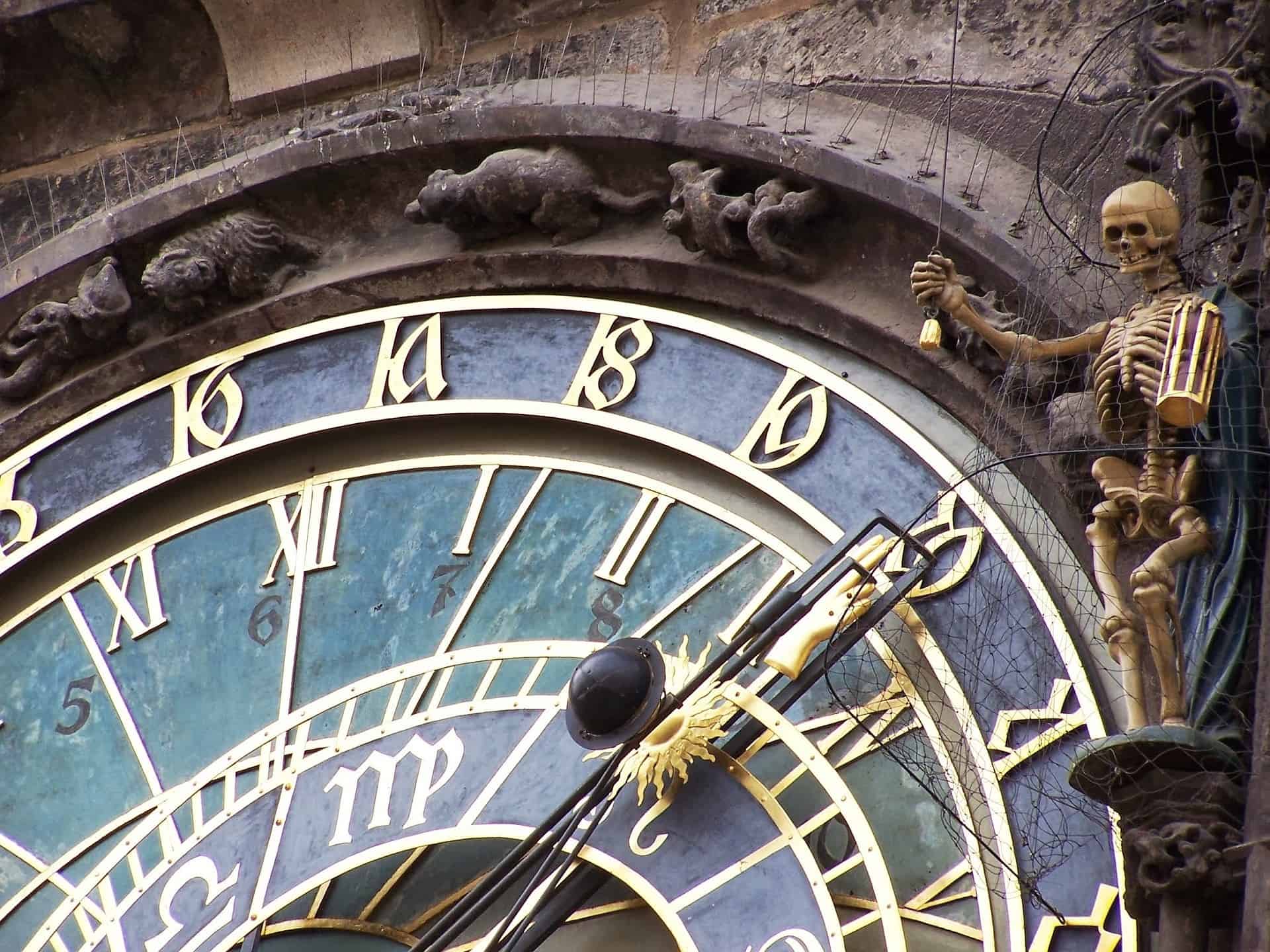
Another legend has to do with the skeleton. It said that if the clock stopped for a long time, the nation will suffer, and the skeleton will nod his head telling all that bad times were coming.
A fascinating discovery was made in 2018 when a metal box was found inside a hollow statue during a refurbishment of the clock.
Inside was an 18-page letter from a sculptor and woodworker named Vojtěch Sucharda. He has been hired to recreate sculptures damaged in WWII.
The letter contained information on his plans for the clock and his frustration at the pushback from Prague's communist conservationists.
Old Town Hall
You can imagine it requires a complicated mechanism on the inside of the Astronomical Clock to track so many different movements.
And you can actually see some of those innards by entering the Old Town Hall.
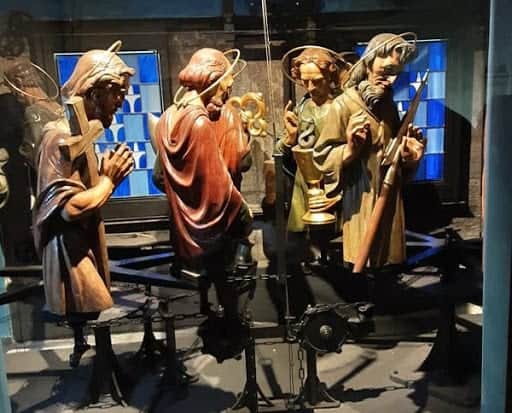
The tower was built in 1364, shortly before the clock itself, and climbing through it can give you a view of the clock’s machinery.
If you’re also looking for a great view of Prague, this is one of the best observation decks in the city, and it’s open to anyone who purchases a ticket to enter the Old Town Hall.
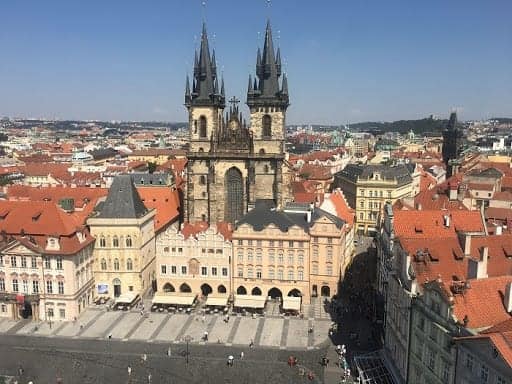
This viewing deck is open even longer than the Old Town Hall itself, with extended hours to 10 pm each night, allowing you to see the city after dark as well.
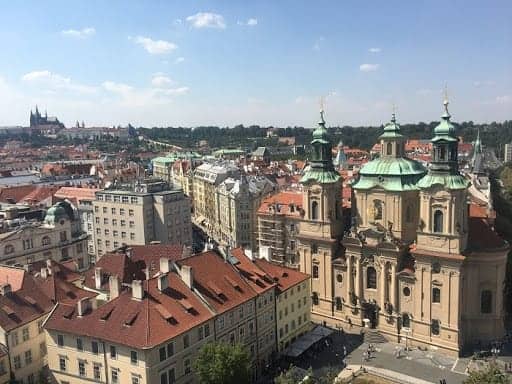
Most of what you can see to the left of the clock is part of the Old Town Hall, including the standout Renaissance building at the end, painted like a Greek vase, which was the former residence of Franz Kafka.
There are several halls inside this historic site which you can see if you purchase a ticket, including the Municipal Hall, the Old Council Hall, the Antechamber to the Assembly Hall, the Brožík Assembly Hall, and the George Hall.
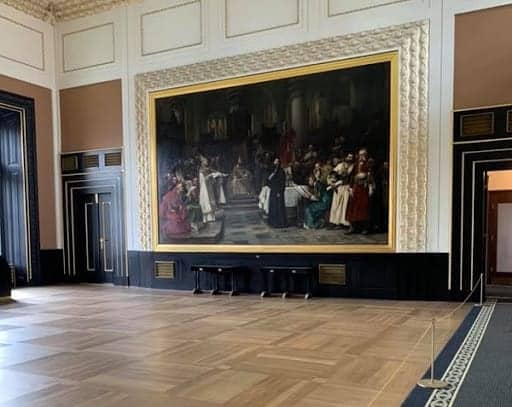
If you take a tour of the interior, they will provide a closer look at these halls and information about the history of how they were used over the years.
Exploring the Old Town Hall from the inside can also get you into an underground portion of the building, part of a broader underground that represents the city’s original street level.
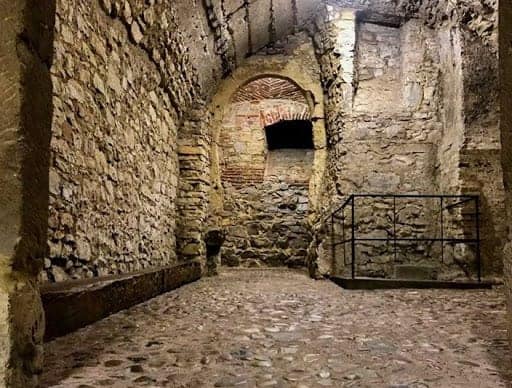
This is one of the oldest parts of the Old Town Hall, and it really gives you an interesting look at some of the architectural styles used throughout the years.
TICKETS AND DISCOUNTS
If you want to enter the Old Town Hall to see the inner workings of the Astronomical Clock, you will have to purchase a ticket.
Admission to the Old Town Hall includes access to the tower’s observation deck, each of the halls inside the structure, as well as the underground area.
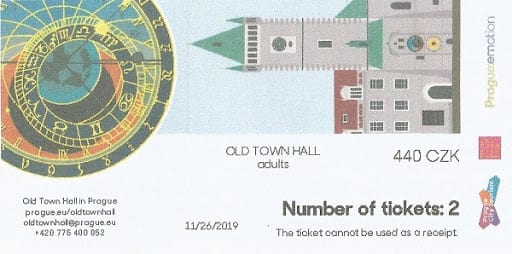
They also offer public tours of these areas at no additional cost.
Ticket Prices
- General Admission: 250 CZK
- Reduced Admission: 150 CZK
- Family Admission: 500 CZK
- Purchase tickets or learn more.
Reduced tickets are available for senior citizens, youth, students, and disabled visitors. Family tickets provide admission for 2 adults and 2 children.
Admission is also available via Prague tourist passes which allow you to save money by paying one flat price for multiple popular attractions and activities.
Hours
- Mondays: 11 am - 7 pm
- Tue-Sun: 9 am - 7 pm
The Astronomical Clock operates year-round on every full hour.
Although admission to this attraction is already pretty affordable, you could save quite a bit of money on tickets with a Prague tourist pass.
The Prague Card includes admission to dozens of popular attractions for 2, 3, or 4 days at a time with one flat price for all of them.

In addition to covering the cost of entering the Old Town Hall to see behind the scenes of the Astronomical Clock, this pass also includes the following popular sites and activities at no additional cost:
- Prague Zoo
- Prague Castle
- Jewish Museum
- St. Vitus Cathedral
- Czech Museum of Music
- Petřín Observation Tower
- Prague Historical Bus Tour
- Prague Venice River Cruise
- And more!
Depending on how you use the pass, you could save up to 50% off these activities and attractions.
If you get the 4-Day Pass, which costs €83 (€20.75 per day), you’ll really only need to use it for 3-4 activities each day to get a good discount.
For more details, please read our post covering Prague tourist passes.
Public Tours
When you purchase admission to the Old Town Hall, you’ll have access to several notable sections of the building and a guided tour which includes a printed guide in 13 languages.
In addition to tours offered during the day, they also provide evening tours every Friday at 8 pm, making it an after-hours visit to the site.
This tour is 2 hours in length and it’s the same price as a general admission ticket (250 CZK).
Each tour will provide additional information about the individual halls located within Old Town Hall, as well as the underground area.
Even if you decide not to enter the building, you can also use our GPS-enabled audio tour to learn more about the Astronomical Clock and the Old Town Hall.
There are also several free (pay-what-you-like) walking tours which include a stop at the Astronomical Clock, which is another excellent way to discover this landmark.
RELATED POSTS:






